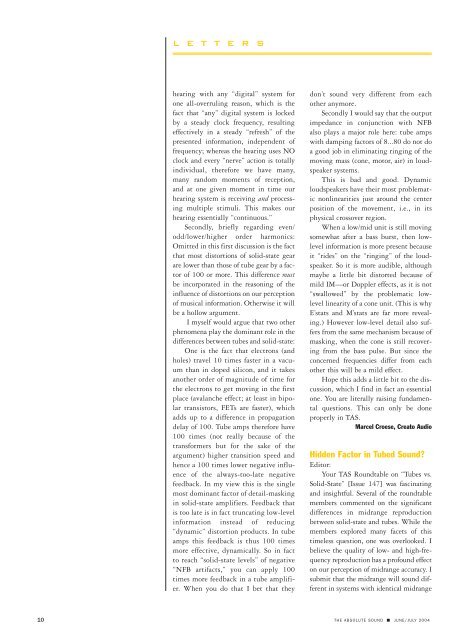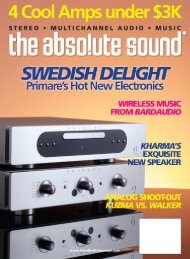Absolute Sound
Absolute Sound
Absolute Sound
Create successful ePaper yourself
Turn your PDF publications into a flip-book with our unique Google optimized e-Paper software.
L E T T E R S<br />
hearing with any “digital” system for<br />
one all-overruling reason, which is the<br />
fact that “any” digital system is locked<br />
by a steady clock frequency, resulting<br />
effectively in a steady “refresh” of the<br />
presented information, independent of<br />
frequency; whereas the hearing uses NO<br />
clock and every “nerve” action is totally<br />
individual, therefore we have many,<br />
many random moments of reception,<br />
and at one given moment in time our<br />
hearing system is receiving and processing<br />
multiple stimuli. This makes our<br />
hearing essentially “continuous.”<br />
Secondly, briefly regarding even/<br />
odd/lower/higher order harmonics:<br />
Omitted in this first discussion is the fact<br />
that most distortions of solid-state gear<br />
are lower than those of tube gear by a factor<br />
of 100 or more. This difference must<br />
be incorporated in the reasoning of the<br />
influence of distortions on our perception<br />
of musical information. Otherwise it will<br />
be a hollow argument.<br />
I myself would argue that two other<br />
phenomena play the dominant role in the<br />
differences between tubes and solid-state:<br />
One is the fact that electrons (and<br />
holes) travel 10 times faster in a vacuum<br />
than in doped silicon, and it takes<br />
another order of magnitude of time for<br />
the electrons to get moving in the first<br />
place (avalanche effect; at least in bipolar<br />
transistors, FETs are faster), which<br />
adds up to a difference in propagation<br />
delay of 100. Tube amps therefore have<br />
100 times (not really because of the<br />
transformers but for the sake of the<br />
argument) higher transition speed and<br />
hence a 100 times lower negative influence<br />
of the always-too-late negative<br />
feedback. In my view this is the single<br />
most dominant factor of detail-masking<br />
in solid-state amplifiers. Feedback that<br />
is too late is in fact truncating low-level<br />
information instead of reducing<br />
“dynamic” distortion products. In tube<br />
amps this feedback is thus 100 times<br />
more effective, dynamically. So in fact<br />
to reach “solid-state levels” of negative<br />
“NFB artifacts,” you can apply 100<br />
times more feedback in a tube amplifier.<br />
When you do that I bet that they<br />
don’t sound very different from each<br />
other anymore.<br />
Secondly I would say that the output<br />
impedance in conjunction with NFB<br />
also plays a major role here: tube amps<br />
with damping factors of 8...80 do not do<br />
a good job in eliminating ringing of the<br />
moving mass (cone, motor, air) in loudspeaker<br />
systems.<br />
This is bad and good. Dynamic<br />
loudspeakers have their most problematic<br />
nonlinearities just around the center<br />
position of the movement, i.e., in its<br />
physical crossover region.<br />
When a low/mid unit is still moving<br />
somewhat after a bass burst, then lowlevel<br />
information is more present because<br />
it “rides” on the “ringing” of the loudspeaker.<br />
So it is more audible, although<br />
maybe a little bit distorted because of<br />
mild IM—or Doppler effects, as it is not<br />
“swallowed” by the problematic lowlevel<br />
linearity of a cone unit. (This is why<br />
E’stats and M’stats are far more revealing.)<br />
However low-level detail also suffers<br />
from the same mechanism because of<br />
masking, when the cone is still recovering<br />
from the bass pulse. But since the<br />
concerned frequencies differ from each<br />
other this will be a mild effect.<br />
Hope this adds a little bit to the discussion,<br />
which I find in fact an essential<br />
one. You are literally raising fundamental<br />
questions. This can only be done<br />
properly in TAS.<br />
Marcel Croese, Creato Audio<br />
Hidden Factor in Tubed <strong>Sound</strong>?<br />
Editor:<br />
Your TAS Roundtable on “Tubes vs.<br />
Solid-State” [Issue 147] was fascinating<br />
and insightful. Several of the roundtable<br />
members commented on the significant<br />
differences in midrange reproduction<br />
between solid-state and tubes. While the<br />
members explored many facets of this<br />
timeless question, one was overlooked. I<br />
believe the quality of low- and high-frequency<br />
reproduction has a profound effect<br />
on our perception of midrange accuracy. I<br />
submit that the midrange will sound different<br />
in systems with identical midrange<br />
10 THE ABSOLUTE SOUND ■ JUNE/JULY 2004










